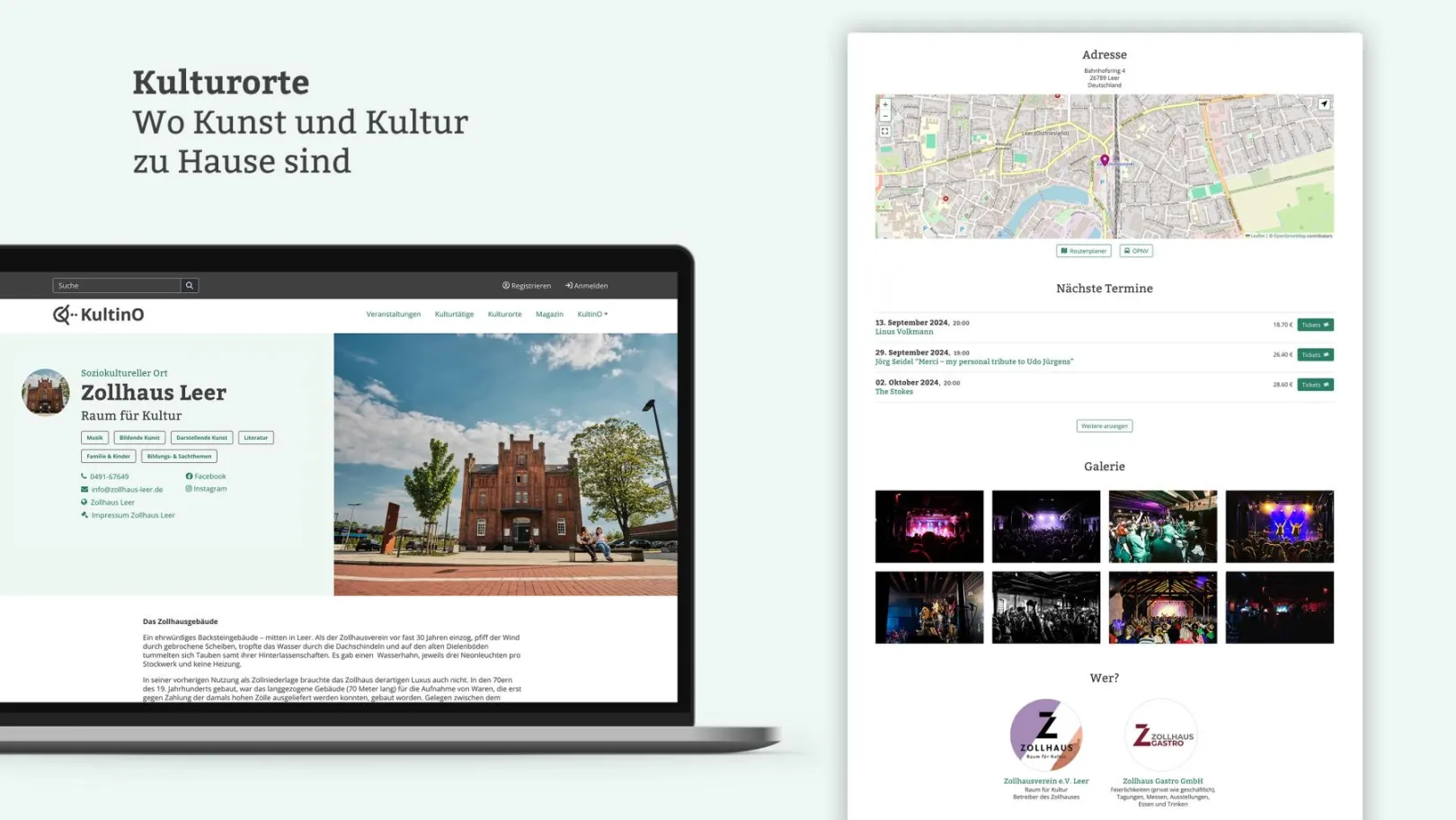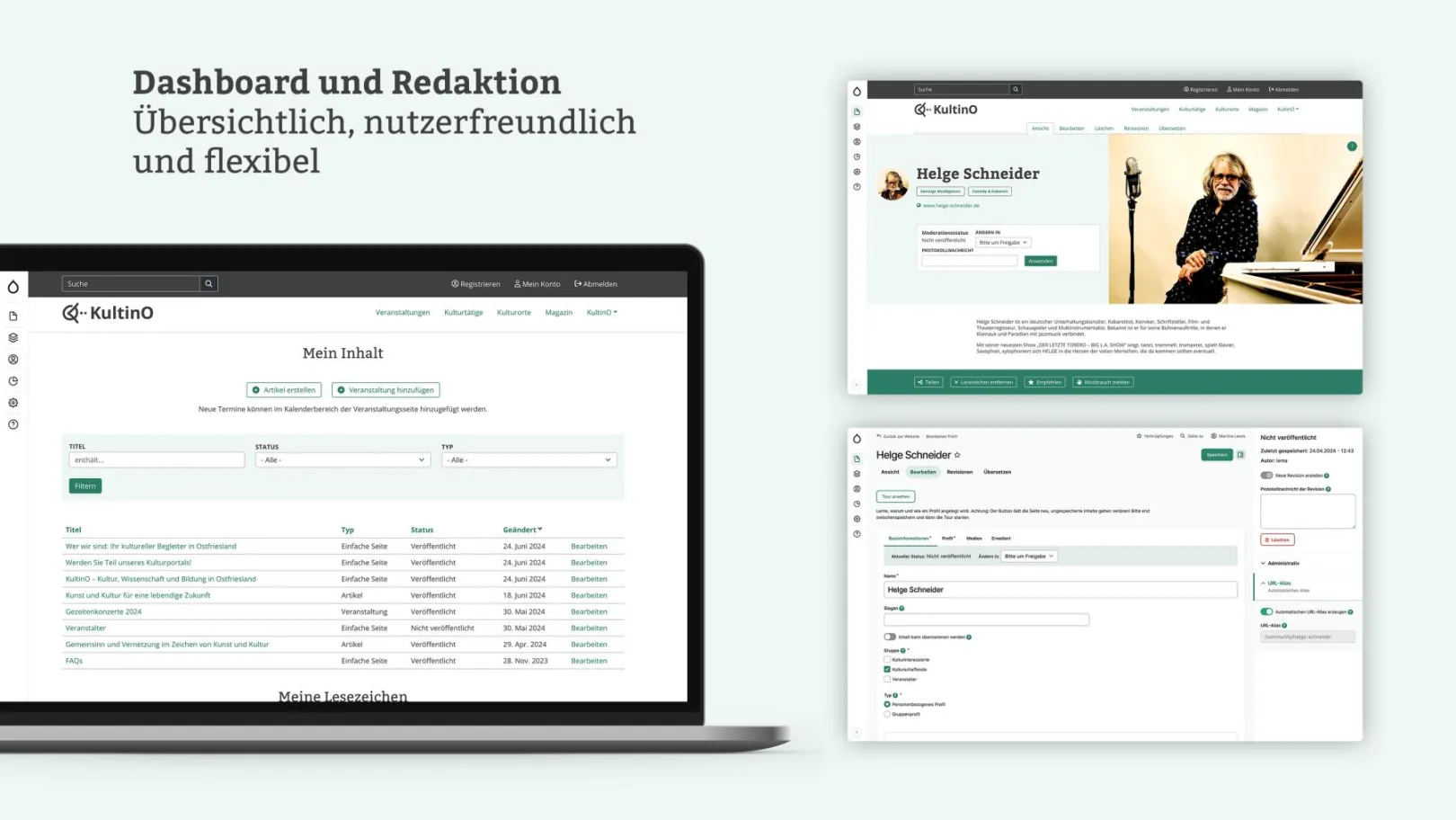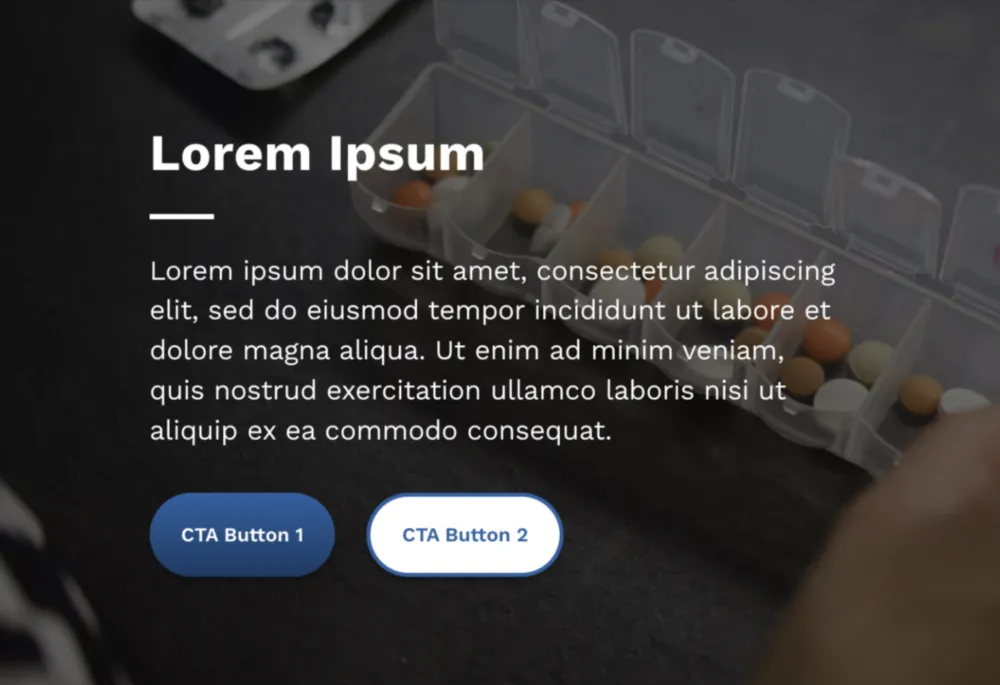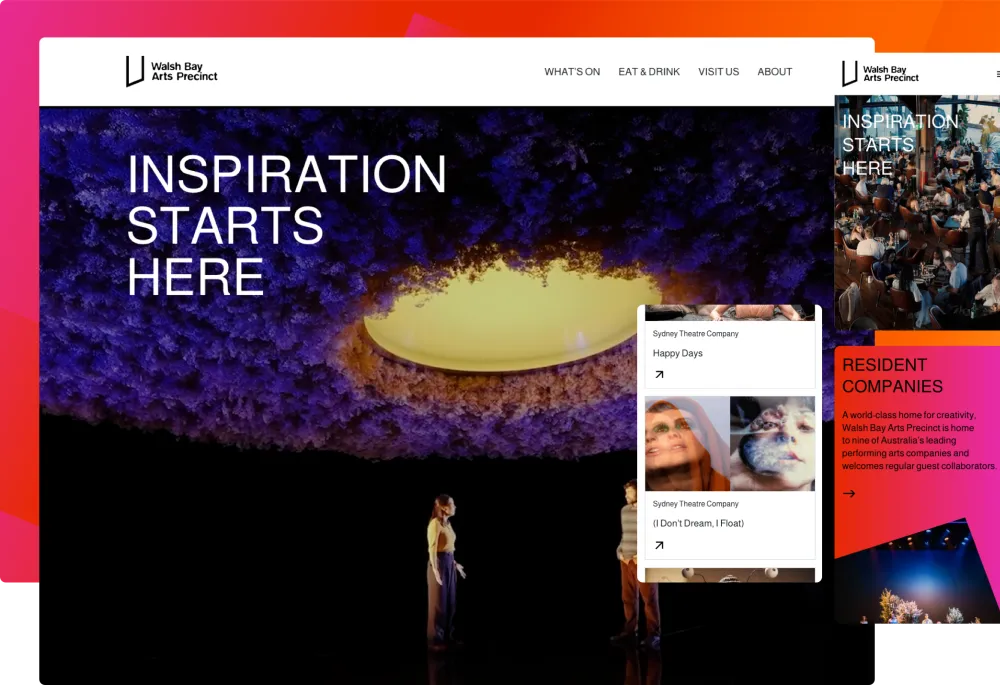Visit the site
Visit the siteOrganizations Involved
Community contributions
We are delighted to be involved in such a lively project - in collaboration with various partners - and to be able to contribute our expertise. In recent years, we have actively worked on patches for the Core and Contrib modules and developed several of our own modules for our distribution and projects. Our goal is to create innovative solutions and continuously improve the platform. The most important modules that we have developed for the KultinO project are listed below.
Core/Contrib
- Leaflet, Geofield, Geocoder, Color Field
- Address
- Smart Date, Add to calendar Date Augmenter
- Attribution & Licensing
- Image Widget Crop, Svg Image
- Matomo
- Display Suite, Display Field Copy, Extra Field
Custom
- OpenCulturas Address Links (Output of addresses as links to public transport or navigation providers)
- Migrate eT4 (Connection to the eT4 interface of Ostfriesland Tourismus GmbH)
- Text Formatters (Collection of field formatters for styling fields in the frontend)
- SVG Favicon (Support for Dark & Light Mode for Favicon)
- Menu Class (Configure CSS classes in menus)
Contributions to Issues
- OpenCulturas: https://drupal.org/i/3462443, https://drupal.org/i/3427070, https://drupal.org/i/3449658, https://drupal.org/i/3449037, https://drupal.org/i/3449030, https://drupal.org/i/3449632, https://drupal.org/i/3415594, https://drupal.org/i/3427109, https://drupal.org/i/3418400, https://drupal.org/i/3415327, https://drupal.org/i/3461794, https://drupal.org/i/3461999
- Attribution & Licensing: https://drupal.org/i/3446531
- Display Suite: https://drupal.org/i/3004362
KultinO, the digital cultural portal for East Frisia (Ostfriesland, Germany), offers a comprehensive calendar of events, an interactive cultural atlas and an informative magazine to make the region's diverse cultural scene accessible and tangible - all free of charge and user-friendly.
Project goals and results
KultinO is an innovative digital cultural portal focussing exclusively on the diverse cultural scene in East Frisia. It offers a comprehensive cultural calendar that includes cultural events from the entire region and thus differs significantly from other event calendars, which often only offer a general overview. Of course, there is also a direct link to ticketing where relevant.
The centrepiece of KultinO is the comprehensive cultural atlas, which serves as an interactive guide to cultural venues and cultural players in East Frisia. Users can search specifically for museums, theatres, galleries and other cultural venues and receive detailed information on the respective offers and activities.
KultinO also offers cultural operators an optimal presentation platform that is specially tailored to their needs and those of cultural events. By networking all entries, cultural players and venues can interact and co-operate with each other. The platform thrives on user-generated content that enables and encourages active participation.
KultinO's informative magazine will offer exciting and well-researched articles on a wide range of cultural topics, highlighting the region's cultural heritage and current developments. Interviews, features and background reports will bring cultural life in East Frisia to life and make it tangible. Another advantage of KultinO is that it is free of charge, making it accessible to all interested parties and promoting cultural participation in East Frisia.
KultinO thus combines a calendar of events, a cultural atlas and a magazine in a user-friendly and free portal that highlights the cultural diversity of East Frisia and makes it accessible to a wide audience. Both the creation of content and the search for events are designed to be intuitive and functional, so that users can find the information they need quickly and easily. The basic functions can be used without registration. With a KultinO account, users can also save watch lists, subscribe to their favourite categories and create public content.
The challenges
During the development of KultinO, particular attention was paid to the user-friendliness and independence of the platform. At the same time, there was a desire for a stringent UI/UX and an open design and presentation of the content. In order to fulfil these requirements, we had to deviate significantly from the basic OpenCulturas frontend theme. The challenge was to keep KultinO as close as possible to the basic installation in the long term in order to be able to benefit from extensions and new features without major customisation effort. As a result, we build on the basic theme and customise it where necessary. To avoid having to compromise on the design of the portal, we tested different setups and modelled them so that the content, which is imported via two interfaces, also fits seamlessly into the website.
In addition to customising the UI, the development of the two interfaces to Reservix and Ostfriesland Tourismus GmbH (OTG) presented the greatest challenge. The Reservix interface had already been prepared by the Cowain agency, while OTG was rewritten by BRANDCODE. The challenge was to integrate the very different data models into the data architecture of KultinO (or OpenCulturas) and to develop solutions for unstructured data in order to make it usable.
One component currently under development is data export to the contractual partners. This is intended to provide a service and make life easier for cultural professionals and eliminate the need to maintain data twice. Other features that we have implemented include the connection to the VBN timetable planner for planning public transport connections by linking and transmitting the destination.
We have also further developed the navigation function already implemented in OpenCulturas in the front end so that it now works not only on Android, but also on iOS and on the desktop and can be used with various map providers. In addition, we have expanded the map-based hit view by integrating coloured event categories within the framework of set markers.
A feature that is currently being developed is a personalised newsfeed that informs registered users about entries that might be of interest to them. This newsfeed can be personalised both in terms of content and location. Users can specify which event data they are interested in and which they would like to be informed about. They are asked for the event category/genre, event location and artists. Users can also specify within which radius of a freely definable starting point they would like to be informed about relevant entries.
The cultural portal 'KultinO' is being implemented as part of a federally funded transfer project within the 'Heimat 2.0' programme. The aim of the project is to implement the existing distribution 'OpenCulturas' and to adapt it to the specific needs of the region. This will be done by adapting and optimising the existing software and by developing and implementing additional functionalities. These modifications and extensions will be developed generically so that they can be used in other contexts. They will also be documented in an understandable way to facilitate further development at a later stage. All adaptations and extensions will be made available for reuse in the 'OpenCulturas' distribution.
Another important goal is the accessibility of the portal, which is a basic requirement for us during development. However, accessibility depends not only on the technical implementation, but also on the design and editorial work, which is a challenge for a portal whose content is 95% user-generated.
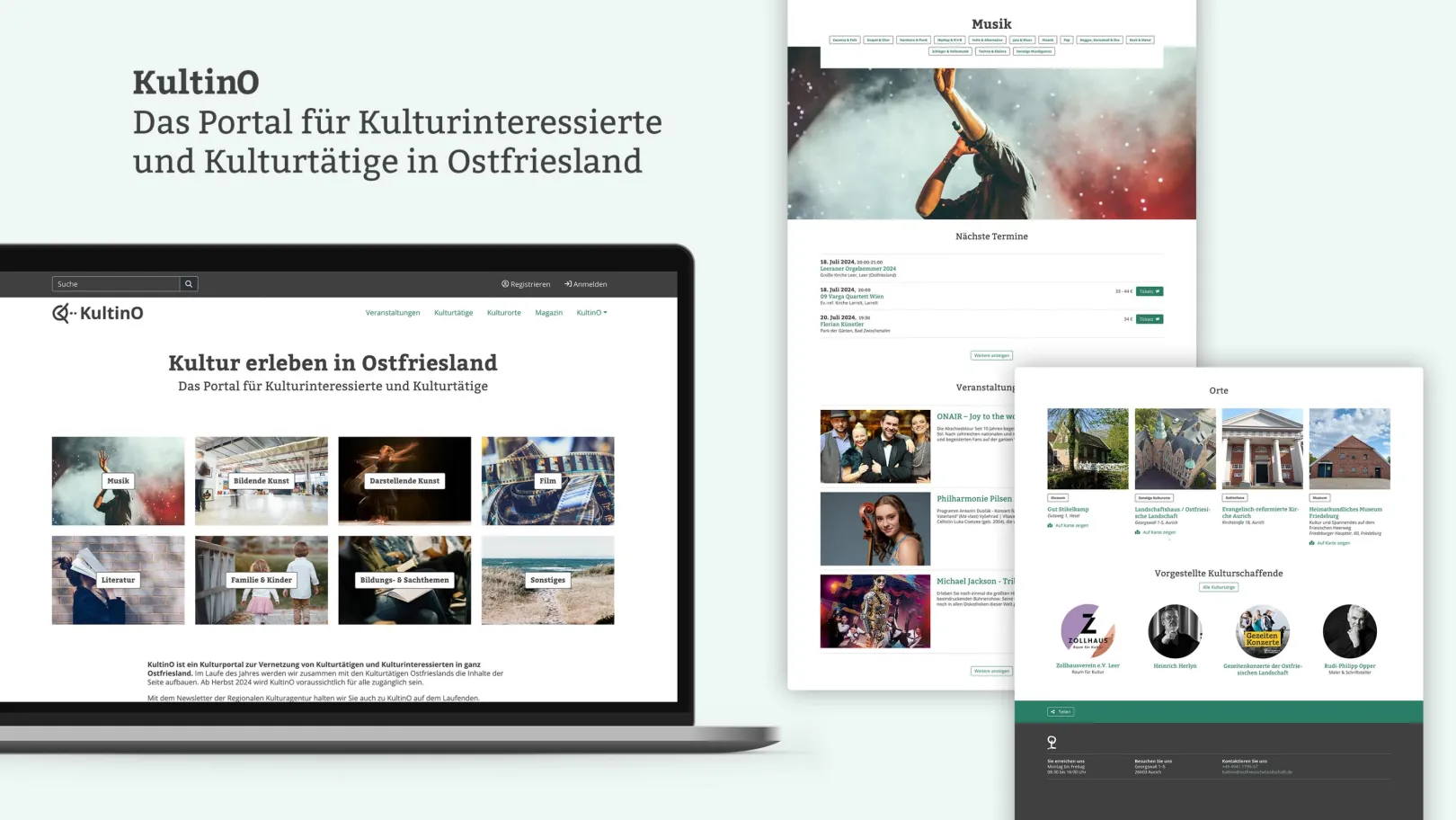
Technical Specifications
Drupal version:
